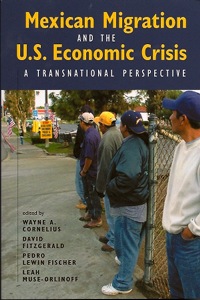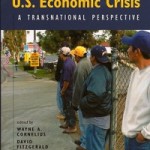Posted by Elena del Valle on April 9, 2010

Mexican Migration and the U.S. Economic Crisis
In the past couple of years, traffic of undocumented immigrants across the Mexico United States border has declined (see Fewer Mexican immigrants arriving, similar number returning home). Thirty-five researchers participating in the Mexican Migration Field Research and Training Program (MMFRP) based in the Center for Comparative Immigration Studies at the University of California, San Diego, and in partnership with Mexican institutions, contributed a summary of their findings on recent migration from Mexico to the United States. Their work, edited by Wayne A. Cornelius, David Fitzgerald, Pedro Lewin Fischer and Leah Muse-Orlinoff, was published this year as a book titled Mexican Migration and the U.S. Economic Crisis A Transnational Perspective (Center for Comparative Immigration Studies, $29.50).
The researchers set out to better understand how economic shocks affect populations movements, specifically those across the Mexico to United States border. They were curious to know how people were managing in places that provided or received immigrants; how individuals were making decision about migrating, staying at home or staying in the United States; and the importance of U.S. immigration enforcement at the border and within the United States in discouraging immigration and encouraging the settling of immigrants in the United States.
The 269-page softcover book is divided into 10 chapters: Introduction; Coping with La Crisis; Double Jeopardy: How U.S. Enforcement Policies Shape Tunkaseño Migration; Economic Crisis vs. Border Enforcement: What Matters Most to Prospective Migrants?; Inhabiting Two Worlds: Tunkaseños in the Transnational Labor Market; Leaving to Learn or Learning to Leave: Education in Tunkás; Values in Conflict: Youth in A Culture of Migration; The Family Dynamics of Tunkaseño Migration; Sweet Dreams and Bitter Realities: Nutrition and Health Care in Tunkás and the United States; and Reshaping Community Participation: Tunkaseños in a Binational Context.

Wayne A. Cornelius, director emeritus, Center for Comparative Immigration Studies (CCIS)
Cornelius is director emeritus, Center for Comparative Immigration Studies (CCIS), University of California-San Diego as well as Distinguished Professor of Political Science. Fitzgerald, associated director, CCIS is author of A Nation of Emigrants: How Mexico Manages Its Migration. Lewin Fischer is senior researcher at the Instituto Nacional de Antropologia e Historia’s Centro Yucatán. Leah Muse-Orlinoff is a Ph.D. candidate in sociology at the University of California, San Diego.

Click here to buy Mexican Migration and the U.S. Economic Crisis
Comments:
Filed Under: Books
Posted by Elena del Valle on August 3, 2009

Flag of Mexico
Because most immigrants to the United States come from Mexico (see Mexico top country of origin of foreign born) many immigration watchers look closely at trends in immigration from that country. Since 2006, the overall number of immigrants from Mexico has declined significantly (see Mexican immigration declined sharply last year). Researchers at the Pew Hispanic Center wondered whether the decline in immigrants would also mean an increase in Mexican born immigrants returning to their country of origin.
The answer is no according to data from Mexican and United States sources such as the United States Population Survey and the United States Border Patrol. A recent study by the Pew Hispanic Center seems to indicate there is no correlation between incoming immigrant and outgoing (from Mexico) numbers.
The Mexico National Survey of Employment and Occupation indicates that 433,000 immigrants returned to Mexico between February 2008 and February 2009 while 440,000 and 479,000 immigrants returned to Mexico for the same period in 2007-2008 and 2006-2007, respectively. An examination of the U.S. Current Population Survey reveals no indication of substantially higher outflows to Mexico for 2007 or 2008.
One third of all foreign-born residents and two-thirds of Hispanic immigrants are from Mexico. At the same time almost all Mexican immigrants move to the United States. Looked at another way, ten percent of people born in Mexico live in the United States.
“Segmentation by Level of Acculturation” audio recording

Presenter Miguel Gomez Winebrenner
Discusses
- Assimilation versus acculturation
- Factors that affect Latino acculturation
- How to know if someone is acculturated
- Number of years necessary for acculturation
- Effects of immigration debate on acculturation
- Three main ways of segmenting Latinos
Click here for details about “Segmentation by Level of Acculturation”
Posted by Elena del Valle on May 20, 2009

Sometimes the United States Border Patrol utilizes horses in difficult terrain
Photo by James Tourtellotte (Border Patrol)
Immigration from Mexico to other countries, including the United States, declined sharply last year, according to an article in The New Times relying on Mexican government census data. The data released recently indicate a decline of 25 percent or 226,000 people immigrating from Mexico to other countries for the year that ended August 2008 compared to the previous year. Most of the immigrants headed to the United States.
Researchers believe that although heightened security at the border has played a role, the change is due mainly to a decrease in illegal crossings because of the economic hardships in the United States; and that the shrinking United States labor market results in fewer worker border crossings.
In addition, the final outflow of migrants from Mexico, taking into account departures and returns, dropped by half for the same time period ending in August 2008, according to data resulting from detailed household interviews conducted quarterly by the census agency in Mexico, the National Institute of Statistics and Geography.
In spite of the economic conditions in the United States the number of Mexicans living in the United States that returned to Mexico did not increase compared to the previous year, according to the Mexican census figures. Just under half a million Mexicans (450,000) returned to Mexico in 2008 as in 2007.
Although the Border Patrol force grew 17 percent to 17,500 agents last year it seems many who wish to reach the United States do in spite of the added security at the United States-Mexico border. However, crossing is expensive and arduous, requiring illegal travelers to rely on smugglers to make the crossing across scorching deserts and hidden mountain terrain. For example reaching Los Angeles from Mexicali, according to immigrants and social workers, costs $3,000 to $5,000 in smugglers’ fees. The high fees combined with lower income make the illegal crossing less appealing.
Eventually, it is likely past immigration patterns from Mexico to the United States will resume. The Center for Comparative Immigration Studies at the University of California, San Diego interviewed one thousand Mexicans in California and in a Yucatan village that has had many migrants in the past. Based on the interviews the researchers concluded that once the job market rebounds in the United States Mexican workers will return.
Discover from a new mom market expert how to reach Latino moms by listening to
“Marketing to New Hispanic Moms – a case study” audio recording

Presenter Cynthia Nelson, COO, Todobebe
Find out about
• New Latina mom market
• Baby demographics including market size, profile
• New moms’ language preferences
• Latino baby market trends
• Factors influencing Hispanic baby market
• Location of new Hispanic moms’ market
• Issues affecting new Latino moms
• Todobebe strategies
Click for information on “Marketing to New Hispanic Moms – a case study”
















